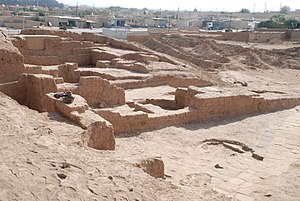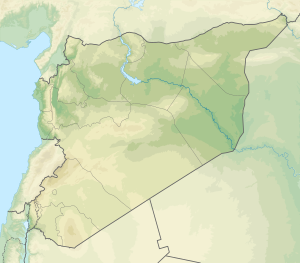
Back تل حلف Arabic Тел Халаф Bulgarian Tell Halaf Catalan Tell Halaf German Tell Halaf Spanish Tall Ḩalaf Estonian Tall Halaf Basque تپه حلاف Persian Tell Halaf French תל חלף HE
This article includes a list of general references, but it lacks sufficient corresponding inline citations. (April 2009) |
تل حلف | |
 Part of the excavated ruins of Tell Halaf | |
| Location | Al-Hasakah Governorate, Syria |
|---|---|
| Coordinates | 36°49′36″N 40°02′23″E / 36.8266°N 40.0396°E |
| Type | settlement |
| History | |
| Founded | c. 6,100 BCE |
| Abandoned | c. 5,400 BCE |
| Periods | Neolithic |
| Cultures | Halaf culture |
| Site notes | |
| Excavation dates | 1911—1913, 1929 2006—present |
| Archaeologists | Max von Oppenheim Lutz Martin Abd al-Masih Bagdo |
| Ownership | Public |
| Public access | Yes |
Tell Halaf (Arabic: تل حلف) is an archaeological site in the Al Hasakah governorate of northeastern Syria, a few kilometers from the city of Ras al-Ayn near the Syria–Turkey border. The site, which dates to the sixth millennium BCE, was the first to be excavated from a Neolithic culture, later called the Halaf culture, characterized by glazed pottery painted with geometric and animal designs.
It is thought to have been historically named Guzana, i.e. the Biblical Gozan.

